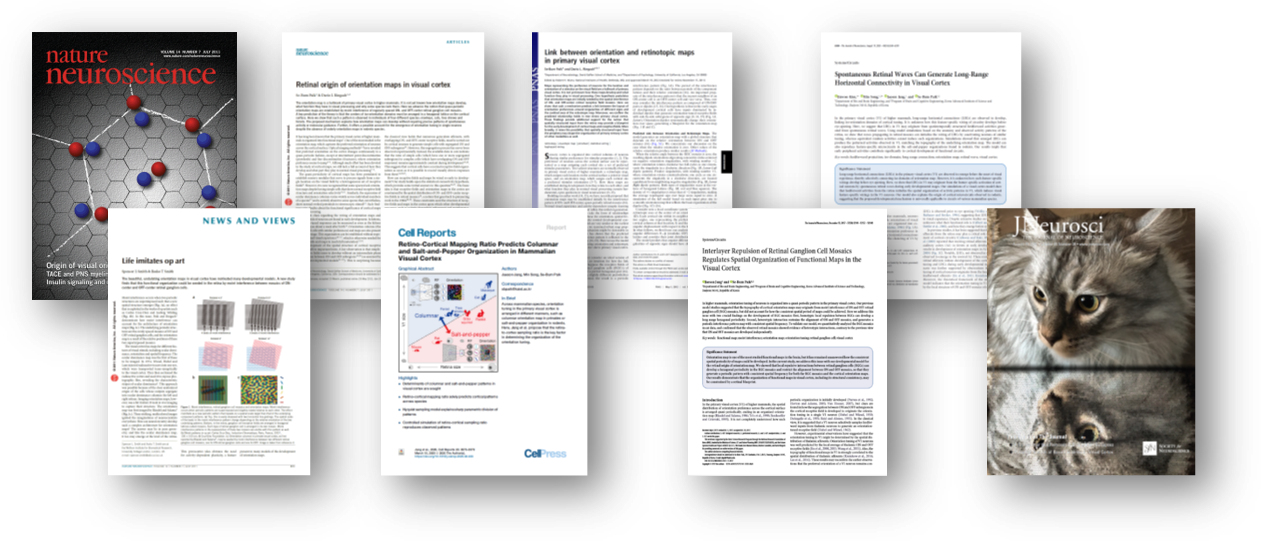
We perform research using tools from computational and theoretical neuroscience, to comprehend a wide range of topics, including the origin and development of cognitive intelligence in both biological and artificial neural networks, the principles of evolution, the behavioral diversity of individuals in multi-agent systems, and many more.
Emergence of Cognitive Intelligence in Natural and Artificial Neural Networks
Can brain functions, like those of artificial neural networks, only be developed through training? How do “innate functions” arise in the brain even before training?
Our research using an artificial neural network model shows that various cognitive functions, such as quantity estimation and object perception, can arise spontaneously in randomly initialized deep neural networks in the complete absence of learning, providing insight into the mechanisms underlying the development of innate cognitive functions.
Our findings provide a broad conceptual advance as well as advanced insight into the mechanisms underlying the origin of primitive functions in both biological and artificial neural networks, which may unravel the mystery of the generation and evolution of intelligence.
Spontaneous Emergence of Functional Circuits in the Brain
“Tabula rasa” vs. “Ex nihilo” - A Biological Strategy Reveals How Efficient Brain Circuitry Develops Spontaneously
Our researches have explained how the regularly structured functional circuits in the brain, such as the topographic tiling of cortical maps, could arise spontaneously to efficiently process sensory information. These researches provide a new framework for understanding functional architectures in the brain during early developmental stages.
Biological Factors Predict Distinct Cortical Organizations across Mammalian Species
We have explained how visual circuits develop uniquely across the brains of different mammalian species. Particularly, we have identified crucial biological factors, such the retino-cortical mapping ratio, that predicts distinct cortical organizations across mammalian species. These new findings have resolved a long-standing puzzle regarding the origin of functional architectures in the sensory system, and demonstrate that the evolutionary variation of biological parameters may induce the development of distinct functional circuits, even without species-specific developmental mechanisms.
Our new findings will provide advanced insights into the mechanisms underlying a biological strategy of brain circuitry for the efficient organization of functional modules, and suggest that a common principle for developing functional architectures may exist.
Computational Algorithm for Brain Circuits Analysis
Unraveling Complex Brain Networks with Automated Neural Analysis
Experimental data analysis is indispensable in neuroscience. However, analyses of brain data obtained thus far have remained heavily dependent on manual processing, which cannot guarantee the accuracy, consistency, and reliability of the results. We address these issues by developing new methods and algorithms of analysis. Our new algorithm brings brain data analysis to a new level.
Development of novel algorithms for brain-equivalent artificial intelligence
Comparative Study between Biological and Artificial Neural Networks
Our previous works show that the biological brain organizes functional circuits and generates fundamental visual functions in a very efficient manner, in contrast to most neural network models of artificial intelligence. For example, the brain successfully performs visual object recognition with a limited number of hierarchical networks that are much shallower than artificial deep neural networks that perform similar tasks.
We are interested in the biological strategy of the brain to implement efficient visual processing, presumably by anatomical structures that are observed in the biological brain but not in artificial neural networks. By comparing functions and structures between the brain and current artificial network models, we want to find critical differences between the two systems, which may lead to a better understanding of the working mechanisms of the brain as well as the implementation of new artificial network models utilizing biological mechanisms.
This may provide advanced insight into the origin of cognitive functions in both artificial and biological neural networks and suggest future directions in the area of biology-inspired computer vision, which optimizes its organization as the biological brain does.
Learning and Memory: Flexible and Stable Memories in the Brain and AI
Emergence of Social Behavior in Multi-Agent System
Collaborated Works
We collaborate closely with a number of leading experimental research groups to support model simulations and computational data processing.

